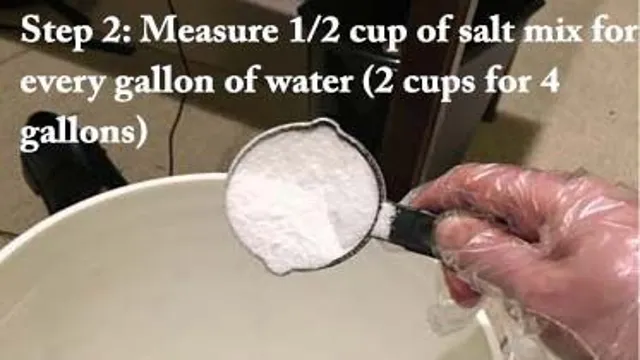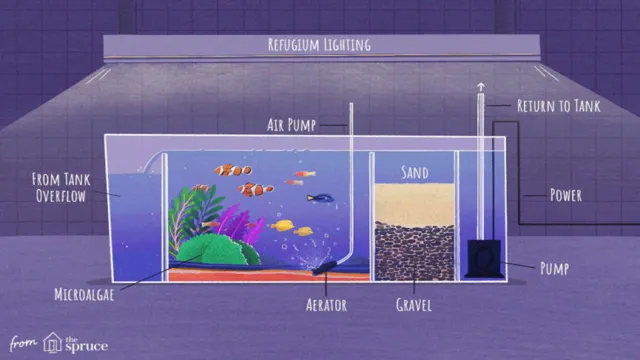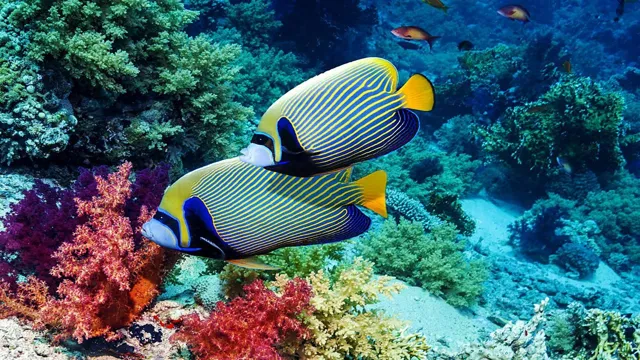Are you ready to take on the challenge of setting up a saltwater aquarium? It may seem daunting, but with the right guidance and preparation, it can be a fulfilling and rewarding experience. To start off, you will need to gather all the necessary equipment such as a tank, lighting and filtration system, live rock, sand, and a heater. It’s important to research and invest in quality equipment to ensure the health and wellbeing of your marine inhabitants.
Next, you will need to cycle your tank to establish a stable environment for your fish and invertebrates. This process involves introducing ammonia and allowing beneficial bacteria to grow and convert it into nitrites and nitrates. It may take several weeks for this cycle to complete, so patience is key.
Once your tank is cycled, it’s time to introduce your aquatic pets. Be sure to research the specific needs of each species and gradually acclimate them to their new home. Saltwater aquariums require regular maintenance such as water changes and testing to ensure appropriate water parameters are maintained.
Maintaining a saltwater aquarium can be a delightful and calming hobby. Just like any living thing, it requires proper care to thrive. With a little bit of time and effort, you can create a beautiful underwater world right in your home.
Gather Necessary Equipment
If you’re ready to start setting up a saltwater aquarium, the first step is to gather all of the necessary equipment. You’ll need a tank, which should be 20 gallons or larger to accommodate the deep sand bed that’s needed for a healthy and stable saltwater environment. You’ll also need a heater, filter, and protein skimmer to maintain water quality, as well as a lighting system to support photosynthesis in any coral or other photosynthetic organisms you plan to keep.
It’s also important to have a hydrometer or refractometer to measure salinity, as saltwater aquariums require a precise level of salt concentration. A substrate, such as sand or crushed coral, and live or dry rock will also be necessary to create a natural environment for your fish and other animals. Finally, don’t forget about accessories like a thermometer, net, and testing kits to monitor water parameters.
By gathering all of the necessary equipment, you’ll be well on your way to creating a thriving saltwater aquarium.
Tank, Filter, Heater, Protein Skimmer, Sand, Live Rock, Lighting
Before setting up your marine aquarium, it’s important to gather all the necessary equipment. The first thing you need is a tank, which should be large enough to provide space for the fish to swim around comfortably and for the necessary equipment to be installed. You will also need a filter to keep the water clean and free of harmful substances.
A heater is also essential to maintain a consistent temperature, making it easier for your fish to thrive. A protein skimmer helps remove organic waste from the water, which will keep your fish healthy. Sand is another essential item, as it provides a natural substrate for the bottom of the tank.
Live rock is another important feature of your aquarium, as it helps to maintain a healthy ecosystem by providing a natural habitat for beneficial bacteria and other organisms. Finally, you’ll need lighting to simulate the natural cycle of light and dark. Remember, each piece of equipment is critical to the overall success of your marine aquarium, so take the time to choose high-quality items that will keep your fish and other aquatic life healthy and thriving.

Prepare the Tank
When it comes to setting up your first saltwater aquarium, it’s essential to prepare your tank correctly. Start by thoroughly cleaning your tank with freshwater and avoid using any soap or chemicals that could harm your future inhabitants. Once everything’s clean and dry, add a layer of substrate to the bottom of your aquarium.
Choose a substrate that will benefit your future tank pets, like aragonite sand, which will help support the growth of coral and other invertebrates. After adding your substrate, start setting up your filtration and heating systems. These elements are crucial for maintaining a healthy environment for your soon-to-be marine friends. (See Also: How Thick is Glass at Georgia Aquarium – The Ultimate Guide to Glass Thicknesses)
Don’t forget to add a thermometer to monitor the water temperature closely. With a clean tank, proper substrate, and correctly installed systems, your saltwater aquarium is well on its way to becoming a beautiful, thriving underwater ecosystem that you and your pets can enjoy for years to come.
Clean Tank, Add Sand and Rocks, Fill with Saltwater
Before introducing any fish to your aquarium, proper preparation is key. The first step in preparing your tank is to ensure that it is clean and free from any contaminants. A thorough cleaning involves scrubbing the walls and floors of the tank, removing any traces of old algae or dirt.
After cleaning, it’s essential to add sand and rocks to the bottom of the tank. This provides a natural environment for your fish to thrive in and can also help with filtration. Once the sand and rocks are in place, fill the tank with saltwater.
It’s crucial to ensure that the water is at the optimal temperature and salinity level for the specific types of fish you plan to introduce. Proper tank preparation is critical in ensuring that your fish have a healthy and happy environment to thrive in. Taking the time to prepare your tank is worth it in the end, ensuring that your fish will thrive for years to come.
Install and Set Up Equipment
Are you interested in making your own saltwater aquarium set but don’t know where to start? Here is a step-by-step guide on how to install and set up equipment for your aquarium. First, choose an appropriate location for your aquarium and make sure it is level. Next, rinse and clean the tank thoroughly with water and a mild detergent.
Install the heater, filter, and protein skimmer according to the manufacturer’s instructions. Then, add live sand and live rock to the tank, creating a natural environment for your fish. Fill the tank with saltwater and let it sit for 24 hours to stabilize the temperature and salinity levels.
Finally, add your fish and other inhabitants to the tank and monitor their behavior closely. Remember to test the water regularly and make necessary adjustments to ensure a healthy and thriving environment. With these steps, you can successfully make your own saltwater aquarium set and enjoy the beauty and tranquility it brings to your home.
Attach Filter and Heater, Set Temperature and Salinity Levels
Setting up a new aquarium can be an exciting but daunting task, especially when it comes to installing and setting up equipment. One of the most important pieces of equipment to add to your aquarium is a filter and heater. Filters help to maintain the water quality by removing debris and harmful chemicals, while a heater keeps the temperature at the ideal level for your fish and other aquatic creatures.
When adding these items, it’s crucial to read the manufacturer’s instructions carefully. Then, attach the filter and heater securely to the tank and make adjustments to the temperature and salinity levels according to the specific needs of the creatures in the aquarium. Remember that different types of fish have different needs and require various water conditions, so be sure to research their requirements beforehand.
With the right equipment and careful attention, your aquarium can quickly become a beautiful and thriving underwater world.
Cycle the Tank
Making a saltwater aquarium set can be a fun and rewarding experience, but it’s important to understand the process of cycling the tank before adding any fish or corals. Cycling the tank involves establishing and maintaining a colony of beneficial bacteria that will convert harmful ammonia and nitrite into less toxic nitrate. This process can take several weeks to a few months, depending on the size of the tank and the efficiency of the filtration system.
To cycle the tank, start by adding a source of ammonia, such as fish food or pure ammonia, and monitor the levels of ammonia, nitrite, and nitrate using a water test kit. As the bacteria begin to colonize, you may see spikes in ammonia and nitrite levels, but these should eventually drop as nitrate levels increase. Regular water changes and the use of beneficial bacteria supplements can help expedite the cycling process and establish a healthy colony of bacteria in the tank. (See Also: How to Clean Outdoor Rocks for Aquarium: A Step-by-Step Guide)
Overall, patience is key when cycling a saltwater tank, but once it’s established, it can provide a beautiful and diverse ecosystem for a variety of aquatic life.
Add Ammonia, Wait for Bacteria to grow, Test Water Quality
If you’re new to aquariums, cycling your tank may seem like a daunting task, but it’s crucial for creating a healthy aquatic environment for your fish. The basic process involves cycling through the nitrogen cycle by adding ammonia to the water and waiting for beneficial bacteria to grow naturally. These bacteria convert harmful ammonia into less toxic nitrites and later into nitrates, which can be removed through regular water changes.
To start the process, add a source of ammonia to your tank, such as fish flakes, and wait for the bacteria to grow. Testing the water quality with a basic water test kit can help determine if the cycle is complete. Once nitrate levels begin to stabilize and ammonia and nitrite levels drop to zero, it’s safe to introduce your fish to their new home.
Remember to continue to test the water regularly and perform water changes as needed to maintain a healthy and stable environment for your aquatic pets to thrive.
Add Livestock and Maintain the Tank
One of the most exciting parts of setting up a saltwater aquarium is adding your new sea creatures! However, before you go out and buy livestock, it’s important to ensure that your tank’s water conditions are stable and favorable for your future inhabitants. Once you’ve tested the water and made any necessary adjustments, it’s time to start adding your desired species. Remember to research each creature’s individual needs and compatibility before adding them to your tank, and introduce them slowly to prevent stress and potential aggression.
In addition to adding livestock, it’s also crucial to regularly maintain your aquarium to keep it healthy and thriving. This includes cleaning and changing the water, monitoring the levels of important nutrients, and ensuring that your filtration system is functioning properly. By properly adding and maintaining your saltwater aquarium, you can create a beautiful underwater paradise for your new aquatic friends!
Introduce Fish and Invertebrates, Monitor Water Quality, Perform Regular Maintenance
If you’re ready to take the plunge into the world of fishkeeping, there are a few things you should keep in mind. Once you’ve set up your aquarium and added your substrate, it’s time to add your fish and invertebrates! Before you do, make sure to check that your water quality is optimal for the species you plan to keep. Each type of fish and invertebrate has its own specific needs when it comes to water pH, temperature, and salinity.
It’s important to monitor your water quality regularly to ensure a healthy environment for your livestock. Once you have your livestock added to the tank, it’s important to perform regular maintenance. This can include cleaning the tank, checking the water parameters, and feeding your fish and invertebrates.
Feeding should be done in small amounts to prevent overfeeding and maintain healthy water conditions. When it comes to cleaning, remember not to change all of the water at once as this can shock your fish. Instead, perform partial water changes regularly.
Overall, keeping fish and invertebrates can be a rewarding hobby as long as you take the necessary steps to maintain a healthy environment. It’s important to research the specific needs of the species you plan to keep and create a routine for monitoring and maintaining your tank. With a little effort, you’ll be able to enjoy the beauty and wonder of underwater life in your own home!
Conclusion
In conclusion, creating a saltwater aquarium is like diving into a whole new world of aquatic adventure. From selecting the perfect tank and picking out the most colorful fish, to mastering the art of water chemistry, it’s a process that requires patience, dedication and a little bit of love. But with the right guidance and a whole lot of salty determination, you’ll soon find yourself swimming in an underwater paradise that’s both beautiful and tranquil. (See Also: How to Make a Floating Ring for Aquarium: A Step-by-Step Guide for Beginners)
So go ahead, take the plunge and start your journey to the ultimate fish tank experience – your oceanic oasis awaits!”
FAQs
What materials are needed to set up a saltwater aquarium?
To set up a saltwater aquarium, you will need an aquarium tank, a stand, filtration systems, a heater, a thermometer, substrate, live rocks, salt mix, and lighting.
How do you cycle a saltwater aquarium?
To cycle a saltwater aquarium, add live rocks and sand to your tank, then wait for bacteria to colonize and the water to stabilize. This process can take several weeks to months.
How often should I change the water in my saltwater aquarium?
It is recommended to change 10-20% of the water in a saltwater aquarium every 2-4 weeks.
What kind of fish can I put in a saltwater aquarium?
Some popular fish for a saltwater aquarium include clownfish, tangs, gobies, and wrasses. It’s important to research and choose fish that are compatible and suitable for the size of your tank.
How do I maintain the salinity levels in my saltwater aquarium?
Regularly test the salinity levels using a hydrometer or refractometer and adjust as needed by adding or removing water.
Can I use tap water for my saltwater aquarium?
It is not recommended to use tap water for a saltwater aquarium due to the presence of chlorine and other harmful chemicals. Use reverse osmosis or distilled water.
How do I prevent and treat common saltwater aquarium diseases?
Proper water quality and regular maintenance can prevent many common diseases. If your fish do get sick, quarantine them and seek advice from a veterinarian or experienced aquarium hobbyist.







